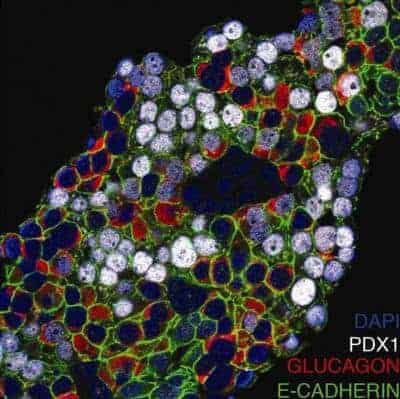In a new study that could ultimately lead to many new medicines, scientists from the Florida campus of The Scripps Research Institute (TSRI) have adapted a chemical approach to turn diseased cells into unique manufacturing sites for molecules that can treat a form of muscular dystrophy.
“We’re using a cell as a reaction vessel and a disease-causing defect as a catalyst to synthesize a treatment in a diseased cell,” said TSRI Professor Matthew Disney. “Because the treatment is synthesized only in diseased cells, the compounds could provide highly specific therapeutics that only act when a disease is present. This means we can potentially treat a host of conditions in a very selective and precise manner in totally unprecedented ways.”
The promising research was published recently in the international chemistry journal Angewandte Chemie.
Targeting RNA Repeats
In general, small, low molecular weight compounds can pass the blood-brain barrier, while larger, higher weight compounds tend to be more potent. In the new study, however, small molecules became powerful inhibitors when they bound to targets in cells expressing an RNA defect, such as those found in myotonic dystrophy.
Myotonic dystrophy type 2, a relatively mild and uncommon form of the progressive muscle weakening disease, is caused by a type of RNA defect known as a “tetranucleotide repeat,” in which a series of four nucleotides is repeated more times than normal in an individual’s genetic code. In this case, a cytosine-cytosine-uracil-guanine (CCUG) repeat binds to the protein MBNL1, rendering it inactive and resulting in RNA splicing abnormalities that, in turn, results in the disease.
In the study, a pair of small molecule “modules” the scientists developed binds to adjacent parts of the defect in a living cell, bringing these groups close together. Under these conditions, the adjacent parts reach out to one another and, as Disney describes it, permanently hold hands. Once that connection is made, the small molecule binds tightly to the defect, potently reversing disease defects on a molecular level.
“When these compounds assemble in the cell, they are 1,000 times more potent than the small molecule itself and 100 times more potent than our most active lead compound,” said Research Associate Suzanne Rzuczek, the first author of the study. “This is the first time this has been validated in live cells.”
Click Chemistry Construction
The basic process used by Disney and his colleagues is known as “click chemistry”—a process invented by Nobel laureate K. Barry Sharpless, a chemist at TSRI, to quickly produce substances by attaching small units or modules together in much the same way this occurs naturally.
“In my opinion, this is one unique and a nearly ideal application of the process Sharpless and his colleagues first developed,” Disney said.
Given the predictability of the process and the nearly endless combinations, translating such an approach to cellular systems could be enormously productive, Disney said. RNAs make ideal targets because they are modular, just like the compounds for which they provide a molecular template.
Not only that, he added, but many similar RNAs cause a host of incurable diseases such as ALS (Lou Gehrig’s Disease), Huntington’s disease and more than 20 others for which there are no known cures, making this approach a potential route to develop lead therapeutics to this large class of debilitating diseases.
In addition to Rzuczek and Disney, the other author of the study, “A Toxic RNA Catalyzes the In Cellulo Synthesis of Its Own Inhibitor,” is HaJeung Park of TSRI. For more information on the study, see http://onlinelibrary.wiley.com/doi/10.1002/anie.201406465/abstract
The work was supported by the Muscular Dystrophy Foundation, the Myotonic Dystrophy Foundation and the State of Florida.


